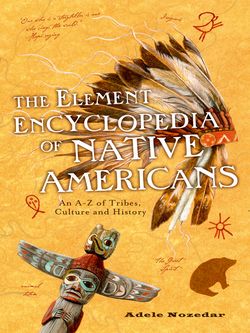Читать книгу The Element Encyclopedia of Native Americans: An A to Z of Tribes, Culture, and History - Adele Nozedar - Страница 55
BLACK ELK
Оглавление“And I say the sacred hoop of my people was one of the many hoops that made one circle, wide as daylight and as starlight, and in the center grew one mighty flowering tree to shelter all the children of one mother and one father.”
1863–1950
That we know so much about the life of Black Elk is because of a man named John Neihardt. As an historian and ethnographer, Neihardt was, in the interests of his personal research, searching out Native Americans who had a perspective on the Ghost Dance Movement. He was introduced to Black Elk in 1930, and thus began a productive collaboration which would provide a major contribution to the Western perspective on Native American life and spirituality—coming, as it did, from an authority on such subjects. The books they produced, including Black Elk Speaks, became classics, and are still in print today.
Living during the time that he did, Black Elk was in a unique position: born into the Oglala Lakota division of the Sioux, he not only participated in the Battle of Little Big Horn in 1876, when he would have been 12 or 13, but also toured as part of Buffalo Bill Cody’s Wild West Show in the 1880s, and traveled to England when the show was performed for Queen Victoria in 1887. He was 27 when the massacre at Wounded Knee took place in 1890, during which he sustained an injury.
Black Elk was a heyoka, a medicine man, and a distant cousin to Crazy Horse. Elk was born in Wyoming in 1863. Acknowledged as a spiritual leader and as a visionary, Black Elk’s first revelation came to him when he was just nine years old, although he did not speak of it until he was older. In this vision, he said, he met the Great Spirit and was shown the symbol of a tree, which represented the Earth and the Native American people.
After Wounded Knee, Black Elk returned to the Pine Ridge Reservation and converted to Christianity. He married Katie War Bonnet in 1892. All three of their children, as well as their mother, embraced the Catholic faith, and in 1903, after Katie died, Black Elk, too, was baptized, although he remained the spiritual leader among his own people. He saw no inherent problems in worshipping both the Christian God and Wakan Tanka, or the Great Spirit—an open-minded attitude which undoubtedly was not shared by his fellow Catholic. Black Elk married once more in 1905, and he and Anna Brings White had three more children. He was one of the few surviving Sioux to have first-hand knowledge of the rituals and customs of the tribe, and he revealed some of these secrets to both Neihardt and Joseph Epes Brown, who published books based on his knowledge.
